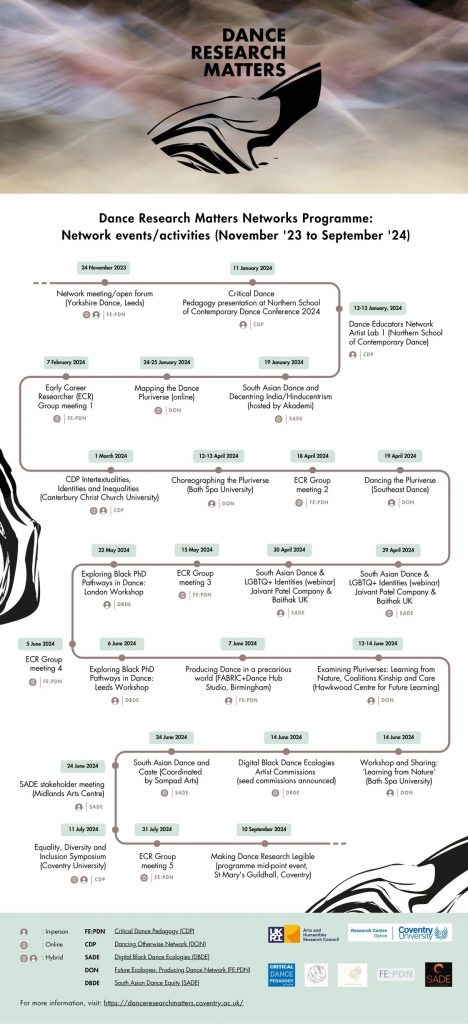Visit the The Blog for Mapping Research Updates
The project ‘Mapping the Dance Research Ecosystem’ maps the system created by the funded Networks and monitors and evaluates their impact. It also facilitates knowledge exchange between the Networks and stakeholders, disseminates progress and results, and provides recommendations for the AHRC and the dance research sector for future direction and strategy.
It is lead by Dr Vipavinee Artpradid (Centre for Dance Research, Coventry University; Ref: AH/Y002105/1)
Please refer to the file below for networks’ events between November 2023 to September 2024.

Work packages
The project is composed of three Work Packages (WPs). These are the Mapping WP, the Monitoring, Evaluation, and Learning (or ‘MEL’) WP, and a WP that provides research and policy recommendations for the AHRC and dance sector.
Three data collection strands will all feed into the WPs. They are the Domain strand (DO), the Network strand (NW), and the Diversity Data strand (DD). The work in the Domain strand is about collecting information that is already there and analysing it based on a set of ‘domains’. These domains are: Spatial (how and where dance research happens), Area Intersections: how and where dance research intersects with other areas of dance, Interdisciplinarity (how and where dance research intersects with other research disciplines), Impact of practice-based research, Career landscape for dance researchers, and Linguistic (language used by dance research community).
The second strand is the Network strand, which focuses on monitoring, evaluating, and learning about the impact of the Network. Three times across the 18 months of the project, each Network will complete a questionnaire that looks at the Network’s impact. The latter is informed by the UKRI definition of impact used in the Research Excellence Framework (REF), which is ‘an effect on, change or benefit to the economy, society, culture, public policy or services, health, the environment or quality of life, beyond academia’ (UKRI 2022). The Programme Lead (PL) collects and analyses all this data into a final impact report in month 18.
The third strand is the Diversity data strand. This strand is about asking everyone involved in the Networks who they are and what their experience of dance research has been like. It will provide a clearer understanding of the career landscape for dance researchers. Collecting robust diversity data provides insight into fair representation in the dance research sector.
The analysis of data from the three strands will be brought together to inform the recommendations piece.